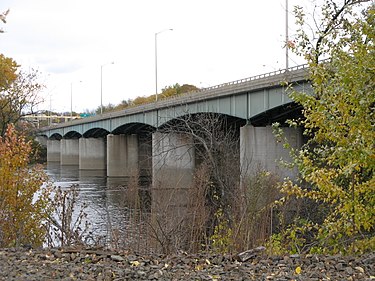Portal:Connecticut
The Connecticut Portal

Connecticut (/kəˈnɛtɪkət/ kə-NET-ik-ət) is the southernmost state in the New England region of the Northeastern United States. It borders Rhode Island to the east, Massachusetts to the north, New York to the west, and Long Island Sound to the south. Its capital is Hartford, and its most populous city is Bridgeport. Connecticut lies between the major hubs of New York City and Boston along the Northeast Corridor, where the New York metropolitan area, which includes six of Connecticut's seven largest cities, extends well into the southwestern part of the state. Connecticut is the third-smallest state by area after Rhode Island and Delaware, and the 29th most populous with slightly more than 3.6 million residents as of 2020, ranking it fourth among the most densely populated U.S. states.
The state is named after the Connecticut River, the longest in New England which roughly bisects the state and drains into the Long Island Sound between the towns of Old Saybrook and Old Lyme. The name of the river is in turn derived from anglicized spellings of Quinnetuket, a Mohegan-Pequot word for "long tidal river". Before the arrival of the first European settlers, the region was inhabited by various Algonquian tribes. In 1633, the Dutch West India Company established a small, short-lived settlement called House of Hope in Hartford. Half of Connecticut was initially claimed by the Dutch colony New Netherland, which included much of the land between the Connecticut and Delaware Rivers, although the first major settlements were established by the English around the same time. Thomas Hooker led a band of followers from the Massachusetts Bay Colony to form the Connecticut Colony, while other settlers from Massachusetts founded the Saybrook Colony and the New Haven Colony; both merged into the former by 1664.
Connecticut's official nickname, the "Constitution State", refers to the Fundamental Orders adopted by the Connecticut Colony in 1639, which is considered by some to be the first written constitution in Western history. As one of the Thirteen Colonies that rejected British rule during the American Revolution, Connecticut was influential in the development of the federal government of the United States. In 1787, Roger Sherman and Oliver Ellsworth, state delegates to the Constitutional Convention, proposed a compromise between the Virginia and New Jersey Plans; its bicameral structure for Congress, with a respectively proportional and equal representation of the states in the House of Representatives and Senate, was adopted and remains to this day. In January 1788, Connecticut became the fifth state to ratify the Constitution. (Full article...)
The 2006 Westchester County tornado was the strongest and largest tornado in Westchester County, New York since the 1904 Chappaqua tornado. It touched down there on Wednesday, July 12, 2006, and traveled 13 miles (21 km) into southwestern Connecticut during a 33-minute span through two states. The tornado touched down at 3:30 p.m. EDT (19:30 UTC) on the shore of the Hudson River before becoming a waterspout and traveling 3 mi (5 km) across the river. Coming ashore, the tornado entered Westchester County and struck the town of Sleepy Hollow at F1 intensity. After passing through the town, it intensified into an F2 tornado and grew to almost a one-quarter mile (400 m) in diameter. The tornado continued through the county, damaging numerous structures, until it crossed into Connecticut at 4:01 p.m. EDT (20:01 UTC). Not long after entering the state, it dissipated in the town of Greenwich at 4:03 p.m. EDT (20:03 UTC). When the tornado entered Westchester County, it was the eighth known tornado to either touch down or enter the county since 1950.
Two barns and a warehouse were destroyed, and a large stained-glass window was shattered. Numerous homes and businesses were damaged and thousands of trees were uprooted. There were no fatalities and only six minor injuries were associated with the storm. The cost of damages was estimated at $12.1 million. (Full article...)List of recognized articles
|
|---|
|
General images -
-
Map of Connecticut showing major highways. (from Transportation in Connecticut)
-
1895 map from Rand McNally (from History of Connecticut)
-
Map showing the Connecticut, New Haven, and Saybrook colonies and the CT-NY dispute (from History of Connecticut)
-
Groton (from List of municipalities in Connecticut)
-
Some bridges on the Merritt Parkway were constructed by workers paid by the US Works Progress Administration (from History of Connecticut)
-
New Haven (from List of municipalities in Connecticut)
-
A 1942 advertisement for recreational lodging in Goshen stating that the facility is not a hotel and caters to Christian clientele specifically. (from History of Connecticut)
-
Governor Jonathan Trumbull (from History of Connecticut)
-
School zones generally have a speed limit of 25 mph. (from Transportation in Connecticut)
-
Hartford (from List of municipalities in Connecticut)
-
The New Haven system (from History of Connecticut)
-
A map showing Connecticut's land claims. (from History of Connecticut)
-
A map showing Connecticut's towns in 1770. (from History of Connecticut)
-
The Charter Oak in Hartford (from History of Connecticut)
-
Pequot War of 1637 (from History of Connecticut)
Selected picture -

State facts
- Nicknames: The Provisions State, The Land of Steady Habits, The Constitution State, The Nutmeg State
- Capital: Hartford
- Governor: D)
- Lieutenant Governor: Susan Bysiewicz (D)
- Secretary of State: Stephanie Thomas (D)
- Attorney General: William Tong (D)
- Senators: Chris Murphy (D), Richard Blumenthal (D)
- Representatives: Jahana Hayes (D), Jim Himes (D), Joe Courtney (D), John B. Larson (D), Rosa DeLauro (D)
- Total area: 5,543 mi2
- Land: 4,845 mi2
- Water: 698 mi2
- Highest elevation: 2,379 ft (Mount Frissell)
- Population 3,576,452 (2015 est)
- Admission to the Union: January 9, 1788 (5th)
State symbols:
- Animal: Sperm whale
- Bird: American Robin
- Fish: American Shad
- Flower: Mountain Laurel
- Fossil: Dinosaur Track
- Insect: European Praying Mantis
- Ship: USS Nautilus (SSN-571)
- Songs: Yankee Doodle
- Tree: Charter Oak
- Mineral: Almandine
Selected article -
Did you know? -
- ... that Darien, Connecticut, was once home to a train station built inside a cemetery?
- ... that a Connecticut TV station was dedicated to the state's first female governor, Ella Grasso, whose son was a minority owner?
- ... that the directors of the Dutchess and Columbia Railroad stole back the railroad from a bankrupt lessee?
- ... that Cora Slocomb di Brazza designed the peace flag adopted by the International Council of Women, and her mother Abby Day Slocomb designed the Connecticut state flag?
- ... that a variety of the Connecticut field pumpkin is known as "the original commercial jack-o'-lantern pumpkin"?
- ... that under a new Connecticut law, abortion providers in the state can countersue anyone who sues them under the Texas Heartbeat Act?
In the news

- February 10: Disney to shut down Blue Sky Studios, animation studio behind 'Ice Age'
- October 17: Hundreds arrested for 'dark web' child porn by international task force
- October 3: World War II era plane crashes in Connecticut, US, killing at least seven
- February 21: Sixteen states sue U.S. President Trump to stop declaration of emergency for border wall
Categories
Related WikiProjects
Selected panorama
Topics
Related portals
Associated Wikimedia
The following Wikimedia Foundation sister projects provide more on this subject:
-
Commons
Free media repository -
Wikibooks
Free textbooks and manuals -
Wikidata
Free knowledge base -
Wikinews
Free-content news -
Wikiquote
Collection of quotations -
Wikisource
Free-content library -
Wikiversity
Free learning tools -
Wikivoyage
Free travel guide -
Wiktionary
Dictionary and thesaurus



























































